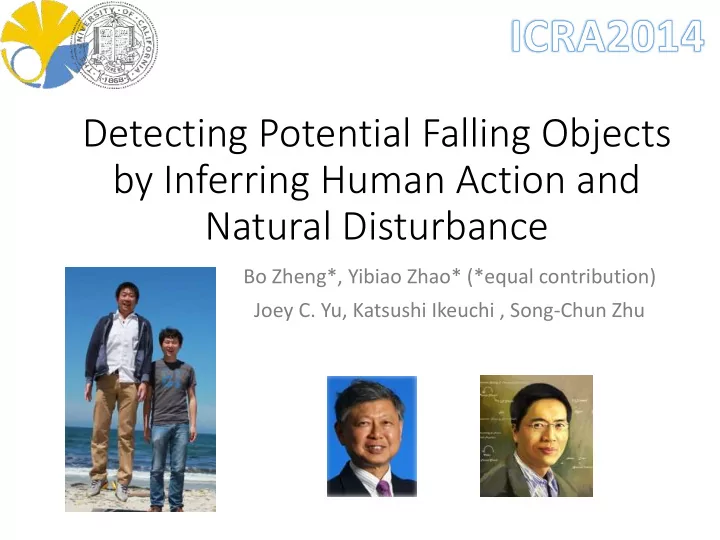

Detecting Potential Falling Objects by Inferring Human Action and Natural Disturbance Bo Zheng*, Yibiao Zhao* (*equal contribution) Joey C. Yu, Katsushi Ikeuchi , Song-Chun Zhu
Goal- understand the potential falling objects “Oh, i t’s dangerous!”
• safety surveillance system, • children, elders and people with disabilities Motivations • Robotics -rescue DARPA robotics
Issues • Human can imagine but machine cannot. • Doing the serious physical simulation? • various collisions • large number of objects • huge variation in size, shape, material Time consuming!
Related work • Physics reasoning – understand support relations • “Block world revisit” [Gupta, ECCV10] • Support relations inference [Silberman, ECCV12] • Blocks, Support, and Stability [Jia, CVPR13] • Support surface prediction [Hoiem, ICCV13] • Cognitive science – Interpret human’s thought • Probabilistic model [Hamrick, CogSc11] • Robotics – avoid the obstacles • Safe motion planning [Petti, IROS05]
Outline • Introduction • motivation • related works • Method • Experimental results • Discussion
Observation – causality of the falling risk • “Cause” – the physical disturbance (energy absorbed) • “Result” – much uncontrolled energy released
Pipeline Physical reasoning Stability 3D scene Physical reasoning Risk Disturbance field evalu Statistics ation Disturbance observation Motion disturbance
Risk evaluation
Part I: Physical reasoning
Physical reasoning [CVPR13, Zheng]
Step 1: Segmentation [CVPR13, Zheng]
[CVPR13, Zheng] Step 2: volumetric completion Holes filled Holes Segmentation result Result of volumetric completion
[CVPR13, Zheng] Step 3: Stability optimization [SWC sampling, A. Babu ’ 03]
Part II: Risk evaluation
Physical risk definition Potential energy Absorb energy Release energy disturbance
Example
Disturbance field by human activities Primary motion Secondary motion
Disturbance field by human activities
Other disturbances human activity earthquake wind
Outline • Introduction • motivation • related works • overview • Method • Experimental results • Discussion
Results of physical reasoning Point cloud segmentation Our method
Results of physical reasoning Point cloud segmentation Our method
Large scale indoor scene
Risk evaluation
Under different disturbances
output input
Outline • Introduction • motivation • related works • overview • Method • Experimental results • Discussion
Discussion: Human v.s. Machine? • There is no ground truth • People have big variance on safety understanding
Thank you for your attention!
Recommend
More recommend